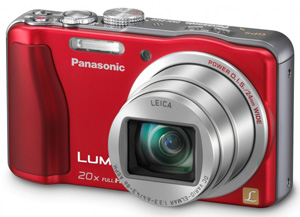Best Compact Superzoom Cameras
FIRST PLACE
Panasonic Lumix DMC-ZS20
Panasonic Lumix DMC-ZS20
Though Panasonic first invented the pocket superzoom camera, they stumbled a bit with last year's DMC-ZS10. This year they've come roaring back to top form with the new DMC-ZS20, an excellent camera that outperforms the competition. When all is said and done, the bottom line is that the ZS20 consistently captures properly focused, well-balanced pictures more reliably than any of the other cameras in this shootout. Beyond that, it has the fastest action, it is the only camera in the group that captures video at 1080p/60, and its continuous autofocus keeps things sharp as you move around in that long 20x zoom range. The Panasonic DMC-ZS20 wins the Best Camera Award in the Compact Superzoom category.


What's HOT about the Panasonic DMC-ZS20:
1. Most reliable camera for taking rich, high saturation, properly focused photos.
2. Long zoom range, from 24mm wide angle to 480mm telephoto.
3. Very sharp lens on the wide angle end, less so but competitive on the telephoto end.
4. Fastest autofocus and capture of single still shots (one each 0.9 sec)
5. Fastest resetting of zoom lens for subsequent still shots
6. Cool touch-screen menu and control--the only one that has it
7. Fill flash results in well-balanced exposures
8. Flash built into the front body, not an annoying pop-up under your left finger
9. Optical image stabilization works beautifully
10. Hard stop at transition from optical to digital zoom! Why can't they all do this?
11. At 7.34 ounces, the lightest of the seven in this group
12. Thin, 1.1 inch deep form factor.
13. Burst mode - 10 frames per sec and full resolution, 4.8 fps with continuous AF
14. Shoots 1080/60p video. Most of them don't.
15. Reasonably good 220 fps movies at ¼ resolution
16. On-board HDR.
17. On-board GPS with mapping.
18. Panorama mode
19. 3D Photo mode
20. Excellent price, lower than group average--outstanding value
What's NOT so hot about the Panasonic DMC-ZS20:
1. Slightly elevated digital noise in bright scenes.
2. Excessive noise in low light exposures with flash
3. Overall image quality competitive with compact superzoom group, but not as good as high performance pocket cameras with short zooms.
3. Auto exposures tend to emphasize blue-green.
4. Slider on-off switch - could turn on accidentally in your pocket
5. Movie button is relatively difficult to hit (this is both good and bad)
6. No RAW recording (none in the group except the Fuji F770 do RAW)
7. GPS chews up battery life (what else is new?)
A Look at the Panasonic DMC-ZS20
Picture Quality. As part of this shootout we found 15 scenes, each with a different set of photographic challenges (shaded subjects, indoor low light, macro close up, daylight high contrast, hand-held max zoom, etc). We photographed these 15 scenes with all seven cameras and ranked the photographs according to sharpness, focus, color balance, dynamic range and exposure accuracy. The Panasonic ZS20 scored the most first place images, usually ranking in the top three with just a few outliers. The bottom line is that, overall, given a variety of shooting situations we were more likely to get a successful photograph from the ZS20 than from any of the other models in this shootout. However, the Canon SX260, the Sony HX9V, and HX10V also did very well in this test, performing similarly to one another and on some images they each beat the ZS20. So it would not be fair to say that the ZS20 has consistently superior image quality to the SX260 or the Sony models. All of these cameras were reasonably reliable compared to the Fuji F770, the Nikon S9300, and the Pentax VS20, which had a higher percentage of images out of focus or in poor color balance.
UPDATE, 6/21/12: Due to its more recent release, the Olympus SZ-31MR was tested separately from the rest of the group. It scored high overall in reliability, but it was not quite as consistent as the ZS20, thus it currently holds second place among the models currently on the market.
Video performance. The ZS20, the Olympus SZ-31MR, and the Sony HX9V are the only three cameras in the shootout capable of full 1080p resolution video at 60 frames per second. But in addition, the ZS20's continuous autofocus performed as well as any in the group, keeping the subject in focus without delay as you shift the zoom lens. Some people might complain about the placement of the movie button, which is on the extreme right corner of the top deck as you look at it from the rear. Putting your finger on that button does not feel completely natural when your hand is in a position to take still shots, which is a good thing. You need to hold the camera slightly differently in order to control the movie button. The designers have evidently put it there specifically to make it hard to hit accidentally. Unlike other cameras in this class, you won't find yourself accidentally recording a movie due to a slip of the finger.
Digital noise. Some commentators have complained that the ZS20 has too much digital noise. Noise can indeed be elevated on the ZS20 in brightly lit scenes, but not objectionably so. In low light scenes, or scenes with flash, more noise is apparent than we'd like to see. Let's compare the ZS20 with the Canon SX260 using the PhotoScope tool:
The test photos in the above link are set to ISO 200, but we encourage you to change them to see the effects of different ISO settings. Take a look at the Colman's Mustard can and the jelly beans in the lower right. The ZS20 shows slightly more noise, but also higher contrast and better sharpness. The ZS20's cooler color temp in auto mode is evident compared to the SX260. But when it comes down to noise, if you want to see what noise looks like, look at the difference between the ZS20 and the Sony HX10V with both cameras set to ISO 800:
In the comparison between the ZS20 and the HX10V at 800 ISO, the Sony shows higher levels of noise as well as color smearing on the Colman can which is pretty much non-existent on the ZS20. Move the magnifying glass to the sea salt jar in the center of the scene. Notice that the ZS20 holds the color blue in the lettering on the jar while the HX10V renders it gray. While you're there, reset the ISO to 100 on both the ZS20 and the HX10V--suddenly the blue is restored on the HX10V. It is still a darker blue than it should be (the ZS20 is more accurate to the original in this scene), but at least the HX10V sees blue better at ISO 100 than it does at 800. But look closely at the blue script. Does the HX10V looks a bit sharper? It should, but that is due to the subtle white ringing around the lettering which is excessive artificial edge enhancement being added by the camera--it is not part of the original scene. Photography purists usually object to cameras adding information to a scene that wasn't there to begin with.
While you are on this Photoscope comparison between the ZS20 and the HX10V with both set to ISO 100, move the magnifying glass up to the red/white fabric with diagonal lined squared. The ZS20 sharply defines red and white, while the HX10V sees red interference in the white lines, reducing contrast and sharpness and rendering the white lines as light pink rather than white. The ZS20 is capable of rendering this pattern more cleanly than either of the Sony models in this shootout, and the Canon SX260 as well.
A Key Trade-off: Superzoom Range vs Picture Quality
Though the Panasonic ZS20 is currently the all-around most capable camera in the compact superzoom category, keep in mind that a very long superzoom lens (especially the retractable variety) will never be as optically precise as a fixed or short zoom lens. So if you are looking for absolute maximum image quality and you are willing to give up the superzoom performance to get it, you should be looking at a high performance pocket camera like the Olympus XZ-1. The XZ-1 takes sharper pictures, but you sacrifice zoom range because its zoom lens is only 3.8x compared to 20x on the ZS20. That means there is a whole world of zoom photography subject matter at your fingertips with the ZS20 that you can't reach with the XZ-1. If you are interested in the difference in picture quality, here are the two cameras side by side:
The Verdict
No camera is perfect and the Panasonic ZS20 has its flaws like every other camera in this shootout. In particular, we'd prefer its auto mode did not have the cool color bias or slight tendency to underexpose. But these can be fixed with onboard adjustments. For the most part, the Panasonic ZS20 shoots high contrast, color rich images that are largely in focus, and does so more reliably than any other camera in this shootout. This is a rapid action camera that takes still pictures faster than any other model in the group, whether you are adjusting zoom between shots or not. The LCD screen is high in contrast, and while not quite as bright as the screen on the Fuji F770, it is among the best in the category as far as visibility in sunlight goes. Continuous autofocus in movie mode works like a champ, keeping subjects in tight focus more accurately than most. The flash is thankfully built into the body so you never have the annoyance of a flash popping up under the left finger, and its autofill sensor provides a very nicely balanced illumination of dark foreground subjects against brightly lit backgrounds. And you get all of this for a remarkably low price ($269 at this writing) compared to many of the other compact superzoom models. Overall, the Panasonic ZS20 is the most solid performer and best value in the compact superzoom camera group, and it wins our Best Camera Award.










